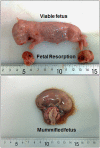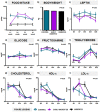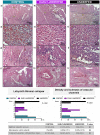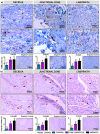Competition for Materno-Fetal Resource Partitioning in a Rabbit Model of Undernourished Pregnancy
- PMID: 28046002
- PMCID: PMC5207739
- DOI: 10.1371/journal.pone.0169194
Competition for Materno-Fetal Resource Partitioning in a Rabbit Model of Undernourished Pregnancy
Abstract
The major goal of animal production is to obtain abundant and healthy meat for consumers. Maternal food restriction (MFR) is often applied in farms to reduce production costs. However, the suitability of MFR in livestock animals is questionable, as this management may compromise maternal fitness due to a severe negative energetic balance and can induce Intrauterine Growth Restriction (IUGR) and prenatal programming in the offspring. Here, we sought to determine, using pregnant rabbits, the consequences of MFR on maternal endocrine and metabolic status and conceptus development. Pregnant dams were distributed into three groups: CONTROL (ad libitum feeding throughout the entire pregnancy; mean pregnancy length being around 31 days), UNDERFED (50% MFR during the entire pregnancy) and EARLY-UNDERFED (50% MFR only during the preimplantation period, Days 0-7). Maternal leptin concentrations and glycemic and lipid profiles were determined throughout pregnancy, whilst conceptus development was assessed ex-vivo at Day 28. Placental parameters were determined by macroscopic and histological evaluations and apoptotic assessments (TUNEL and Caspase-3). The main results of the study showed that, despite MFR altered maternal plasma lipid concentration (P<0.05), there were no effects on maternal bodyweight, plasma leptin concentration or glycemic profile. Fetal crown-rump lengths were reduced in both undernourished groups (P<0.001), but a significant reduction in fetal weight was only observed in the UNDERFED group (P<0.001). Growth in both undernourished groups was asymmetrical, with reduced liver weight (P<0.001) and significantly increased brain: fetal weight-ratio (P<0.001) and brain: liver weight-ratio (P<0.001) when compared to the CONTROL group. A significant reduction in placental weight was only observed in the UNDERFED group (P<0.001), despite both undernourished groups showing higher apoptotic rates at decidua and labyrinth zone (P<0.05) than the CONTROL group. Thus, these groups evidenced signs of placental degeneration, necrosis and stromal collapse. In summary, MFR may encourage the mother to make strategic decisions to safeguard her metabolic status and fitness at the expense of growth reduction in the litter, resulting in enhanced apoptotic and pathological processes at placental level and IUGR.
Conflict of interest statement
There is no conflict of interest that would prejudice the information offered in the paper, excepting that AG-B is a PLOS ONE Editorial Board member. However, this does not alter the authors’ adherence to all the PLOS ONE policies on sharing data and materials.
Figures





Similar articles
-
Maternal glucocorticoid treatment modulates placental leptin and leptin receptor expression and materno-fetal leptin physiology during late pregnancy, and elicits hypertension associated with hyperleptinaemia in the early-growth-retarded adult offspring.Eur J Endocrinol. 2001 Oct;145(4):529-39. doi: 10.1530/eje.0.1450529. Eur J Endocrinol. 2001. PMID: 11581014
-
Maternal undernutrition during late gestation-induced intrauterine growth restriction in the rat is associated with impaired placental GLUT3 expression, but does not correlate with endogenous corticosterone levels.J Endocrinol. 2002 Jul;174(1):37-43. doi: 10.1677/joe.0.1740037. J Endocrinol. 2002. PMID: 12098661
-
Increased placental apoptosis in maternal food restricted gestations: role of the Fas pathway.Placenta. 2009 Sep;30(9):739-51. doi: 10.1016/j.placenta.2009.06.003. Epub 2009 Jul 18. Placenta. 2009. PMID: 19616844
-
Nutritionally mediated placental growth restriction in the growing adolescent: consequences for the fetus.Biol Reprod. 2004 Oct;71(4):1055-62. doi: 10.1095/biolreprod.104.030965. Epub 2004 Jun 16. Biol Reprod. 2004. PMID: 15201203 Review.
-
Physiological and pathological regulation of feto/placento/maternal leptin expression.Biochem Soc Trans. 2001 May;29(Pt 2):86-90. doi: 10.1042/0300-5127:0290086. Biochem Soc Trans. 2001. PMID: 11356133 Review.
Cited by
-
Placental vascular alterations are associated with early neurodevelopmental and pulmonary impairment in the rabbit fetal growth restriction model.Sci Rep. 2022 Nov 16;12(1):19720. doi: 10.1038/s41598-022-22895-6. Sci Rep. 2022. PMID: 36385147 Free PMC article.
-
Chronic Undernutrition in Ovine Twin Pregnancies Abolishes Differences in Birth Weight Due to Sex: An Evaluation of the Role of Nutritional and Antioxidant Supplementation.Animals (Basel). 2024 Mar 21;14(6):974. doi: 10.3390/ani14060974. Animals (Basel). 2024. PMID: 38540071 Free PMC article.
-
Placental adaptations supporting fetal growth during normal and adverse gestational environments.Exp Physiol. 2023 Mar;108(3):371-397. doi: 10.1113/EP090442. Epub 2022 Dec 9. Exp Physiol. 2023. PMID: 36484327 Free PMC article. Review.
-
Intrauterine xenotransplantation of human Wharton jelly-derived mesenchymal stem cells into the liver of rabbit fetuses: A preliminary study for in vivo expression of the human liver genes.Iran J Basic Med Sci. 2018 Jan;21(1):89-96. doi: 10.22038/IJBMS.2017.24501.6098. Iran J Basic Med Sci. 2018. PMID: 29372042 Free PMC article.
-
The Role of Offspring Genotype-By-Sex Interactions, Independently of Environmental Cues, on the Phenotype Traits of an Obese Swine Model.Biology (Basel). 2020 Dec 4;9(12):445. doi: 10.3390/biology9120445. Biology (Basel). 2020. PMID: 33291637 Free PMC article.
References
-
- Barker DJ. The developmental origins of adult disease. J Am Coll Nutr. 2004;23(6 Suppl):588s–95s. - PubMed
MeSH terms
Substances
LinkOut - more resources
Full Text Sources
Other Literature Sources
Medical
Research Materials

